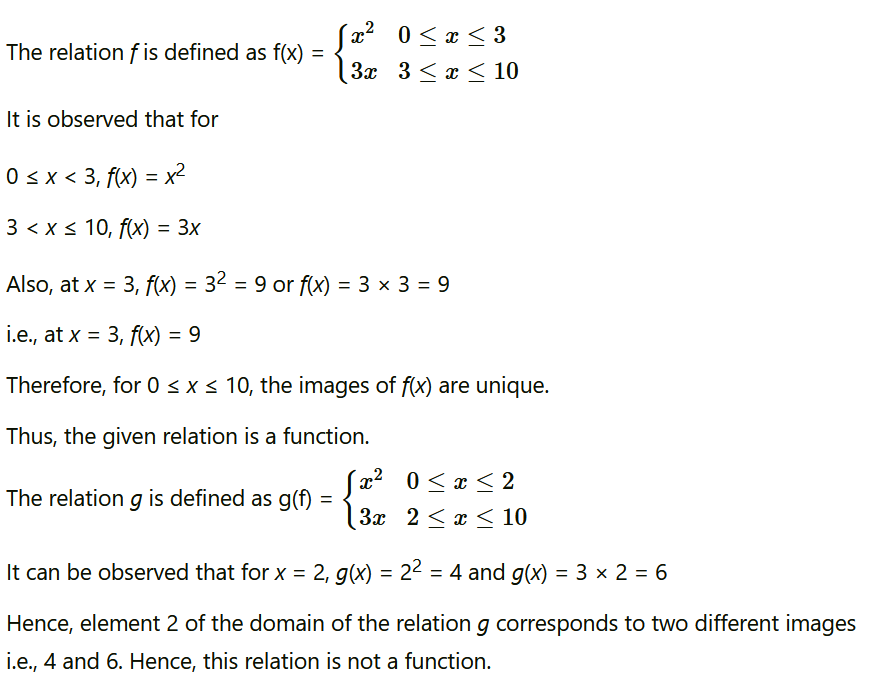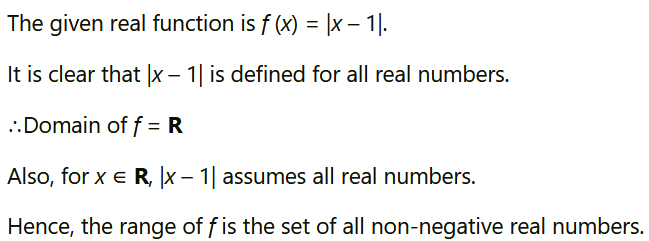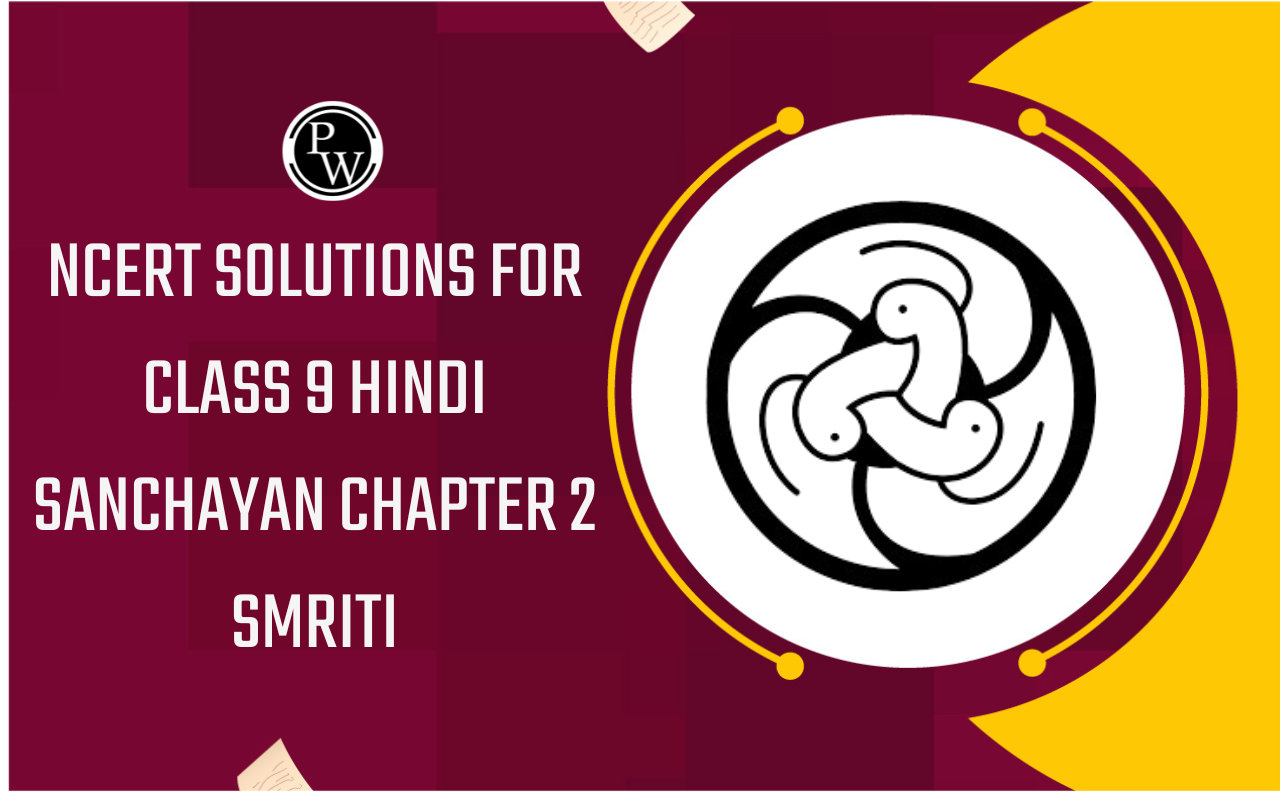
NCERT Solutions For Class 11 Maths chapter-2 Relations And Functions Miscellaneous Exercise
NCERT Solutions For Class-11 Maths Chapter 2 Relations And Functions Miscellaneous Exercise prepared by the expert of Physics Wallah score more with Physics Wallah NCERT Class-11 maths solutions. You can download solution of all chapters from Physics Wallah NCERT solutions of class 11.
NCERT Solutions for Class-11 Maths Miscellaneous Exercise
Question
1. The relation
f
is defined by
 .
.
The relation
g
is defined by
 . Show that f is a function and g is not a function.
. Show that f is a function and g is not a function.
Solution :
Given: f and

Question
2. If f(x) = x
2
find

Solution :
Given:
f(x) = x
2
At

Question
3. Find the domain of the function

Solution :

Question 4. Find the domain and range of the real function f defined by f(x) = √|x - 1|
Solution :
The given real function is f(x)=
√|
x−1
It can be seen that
√|
x−1
is defined for (x−1)≥0
i.e., f(x)=
√|
(x−1)
is defined for x≥1
Therefore the domain of f is the set of all real numbers greater than or equal to 1 i.e.,
the domain of f =[1,∞)
As x≥1
⇒(x−1)≥0
⇒
√|
x−1≥0
f(x)≥0
Therefore the range of f is the set of all real numbers greater than or equal to 0
i.e., the range of f =[0,∞)
Question 5. Find the domain and the range of the real function f defined by f (x) = |x – 1|.

Question
6. Let
 be a function from R into R. Determine the range of f
be a function from R into R. Determine the range of f
Solution :
Here
Put

substituting values and Determing the image , we have

Question 7. Let R → R be defined respectively by Find f(x) = x + 1, g(x) = 2x – 3. Find f + g, f – g and f/g.
Solution :
Given: We have the functions defined as, f,g:R→Ris defined as, f(x)=x+1,g(x)=2x−3
Thus, the function
(f+g)(x)=f(x)+g(x)
=(x+1)+(2x−3)
=3x−2
So, the function (f+g)(x)=3x−2
.
Again, the function,
(f−g)(x)=f(x)−g(x)
=(x+1)−(2x−3)
=−x+4
So, the function (f−g)(x)=−x+4
.
Similarly,
(fg)(x)=f(x)g(x)
where g(x)≠0 and also x∈R
.
Now, putting the values,
(fg)(x)=x+12x−3
where,
2x−3≠0
⇒x≠32
Question 8. Let f = {(1, 1), (2, 3), (0, –1), (–1, –3)} be a function from Z to Z defined by f(x) = ax + b, for some integers a, b. Determine a, b.
Solution :
f = {(1, 1), (2, 3), (0, –1), (–1, –3)}
f(x) = ax + b
(1, 1) ∈ f
⇒ f(1) = 1
⇒ a × 1 + b = 1
⇒ a + b = 1
(0, –1) ∈ f
⇒ f(0) = –1
⇒ a × 0 + b = –1
⇒ b = –1
On substituting b = –1 in a + b = 1, we obtain a + (–1) = 1 ⇒ a = 1 + 1 = 2.
Thus, the respective values of a and b are 2 and –1.
Question 9. Let R be a relation from N to N defined by R = {(a, b): a, b ∈ N and a = b2}. Are the following true?
(i) (a, a) ∈ R, for all a ∈ N
(ii) (a, b) ∈ R, implies (b, a) ∈ R
(iii) (a, b) ∈ R, (b, c) ∈ R implies (a, c) ∈ R.
Justify your answer in each case.
Solution :
R = {(a, b): a, b ∈ N and a = b2}
(i) It can be seen that 2 ∈ N;however, 2 ≠ 22 = 4.
Therefore, the statement “(a, a) ∈ R, for all a ∈ N” is not true.
(ii) It can be seen that (9, 3) ∈ N because 9, 3 ∈ N and 9 = 32.
Now, 3 ≠ 92 = 81; therefore, (3, 9) ∉ N
Therefore, the statement “(a, b) ∈ R, implies (b, a) ∈ R” is not true.
(iii) It can be seen that (16, 4) ∈ R, (4, 2) ∈ R because 16, 4, 2 ∈ N and 16 = 42 and 4 = 22.
Now, 16 ≠ 22 = 4; therefore, (16, 2) ∉ N
Therefore, the statement “(a, b) ∈ R, (b, c) ∈ R implies (a, c) ∈ R” is not true.
Question 10. Let A = {1, 2, 3, 4}, B = {1, 5, 9, 11, 15, 16} and f = {(1, 5), (2, 9), (3, 1), (4, 5), (2, 11)}. Are the following true?
(i) f is a relation from A to B (ii) f is a function from A to B. Justify your answer in each case.
Solution :
A = {1, 2, 3, 4} and B = {1, 5, 9, 11, 15, 16}
∴A × B = {(1, 1), (1, 5), (1, 9), (1, 11), (1, 15), (1, 16), (2, 1), (2, 5), (2, 9), (2, 11), (2, 15), (2, 16), (3, 1), (3, 5), (3, 9), (3, 11), (3, 15), (3, 16), (4, 1), (4, 5), (4, 9), (4, 11), (4, 15), (4, 16)}
It is given that f = {(1, 5), (2, 9), (3, 1), (4, 5), (2, 11)}
(i) A relation from a non-empty set A to a non-empty set B is a subset of the Cartesian product A × B.
It is observed that f is a subset of A × B.
Thus, f is a relation from A to B.
(ii) Since the same first element i.e., 2 corresponds to two different images i.e., 9 and 11, relation f is not a function.
Question 11. Let f be the subset of Z × Z defined by f = {(ab, a + b): a, b ∈ Z}. Is f a function from Z to Z: justify your answer.
Solution :
The relation f is defined as f = {(ab, a + b): a, b ∈ Z}
We know that a relation f from a set A to a set B is said to be a function if every element of set A has unique images in set B.
Since 2, 6, –2, –6 ∈ Z, (2 × 6, 2 + 6), (–2 × –6, –2 + (–6)) ∈ f
i.e., (12, 8), (12, –8) ∈ f
It can be seen that the same first element i.e., 12 corresponds to two different images i.e., 8 and –8. Thus, relation f is not a function.
Question 12. Let A = {9, 10, 11, 12, 13} and let f: A → N be defined by f(n) = the highest prime factor of n. Find the range of f.
Solution :
f(n)= the highest prime factor of n
.
The prime factor of 9 is 3
.
The prime factors of 10 is 2,5
.
The prime factor of 11 is 11
.
The prime factor of 12 is 2,3
.
The prime factor of 13 is 13
.
Thus, it can be said,
f(9) = the highest prime factor of 9=3
f(10) = the highest prime factor of 10=5
f(11) = the highest prime factor of 11=11
f(12) = the highest prime factor of 12=3
f(13)= the highest prime factor of 13=13
.Now, the range of the function will be, {3,5,11,13}
.









